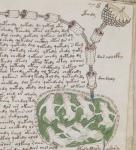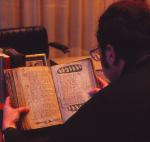The Voynich Manuscript is just as good a story now as when I first read about it 50 years ago. If you’re not familiar with  Voynich Manuscript it, Wikipedia’s article hits the highlights, and its bibliography gives a number of ways to dig deeper.
Voynich Manuscript it, Wikipedia’s article hits the highlights, and its bibliography gives a number of ways to dig deeper.
The Voynich Manuscript was probably written in the early 1400s, probably in Europe, possibly in Northern Italy. Most of it resembles an herbal (though the plants are unrecognizable), plus sections whose pictures suggest astrology and pharmacy, plus lots of naked and clothed women (only the naked ones get mentioned much), and less-understandable illustrations and pure-text pages. The text appears to be written in a cipher, which has tantalized and taunted people since the 1500s. No one has ever cracked it.
Not only is this book truly, deeply weird, so are several of the people and institutions associated with it. Certainly including Roger Bacon, Emperor Rudolph II (who sought weirdos, and found them), John Dee, Wilfrid Voynich, and William R. Newbold. Possibly Yale’s Beinecke Library, where marble panels substitute for clear windows. Maybe even me – Yale let me look through and photograph the Voynich Manuscript in 1980, and I thank them again for the privilege.
I told the Bay Area Skeptics about the Voynich Manuscript at its meeting on December 12, 2012, in Berkeley. The room was packed, and even the venue manager listened intently.
Psychology prof Sheldon Helms was not the only audience member who questioned if the manuscript’s characteristics could be matched to a psychological condition. Some people concoct private writing, some of it meaningful at least to them, some of it not even that.
Spelling in ANY phonetic language was loose and approximate through the 1700s. Among my university students, even in 2012 some hand in papers with the same word spelled 2 different ways. Cryptanalysts may assume an unrealistically high standard of perfect consistency in writing.
The audience regarded Hoax and Fraud as quite likely explanations for the Voynich Manuscript, echoing more and more investigators.
I’ll post several ideas about the Voynich Manuscript in coming days on my own blog. Sperling “reads” Voynich
Sperling “reads” Voynich
